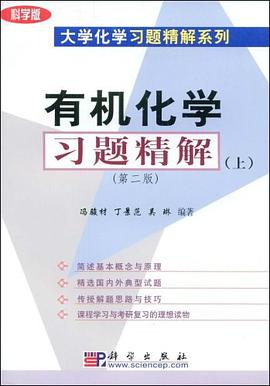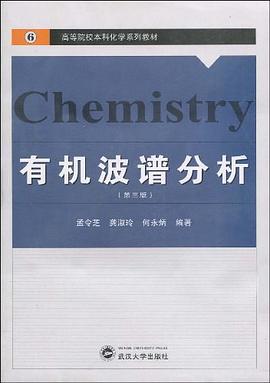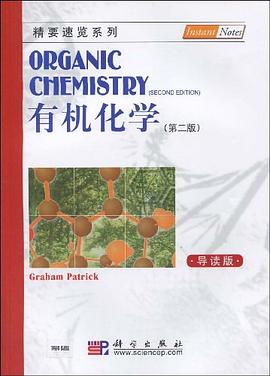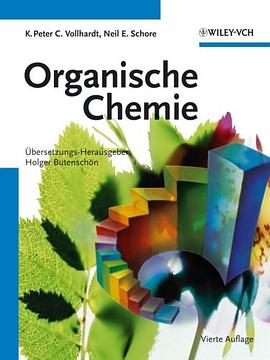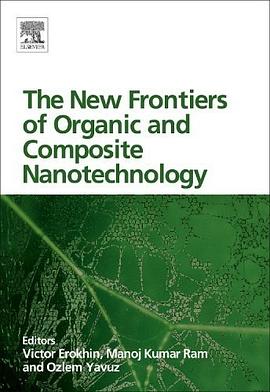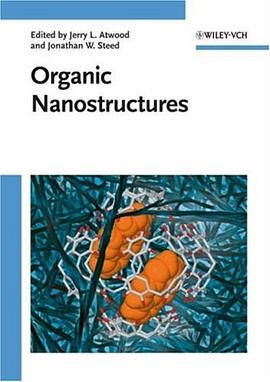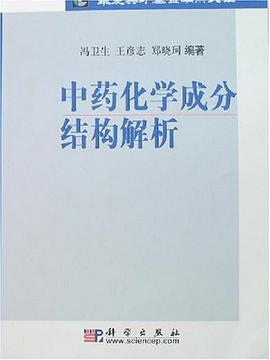

具體描述
《有機化學》(第6版)是L.G.Wade編寫的Organic Chemistry(Sixth Edition)的改編版,是根據教育部關於高等學校本科教學質量工程要重視雙語教學的文件精神,選擇國外優秀英文原版有機化學教材,結閤雙語教學的實踐經驗改編而成的雙語教材。全書共26章,涵蓋內容與國內高等學校化學、化工類有機化學教材基本一緻,包括有機化學概論、有機化閤物命名、立體化學、結構錶徵、烴及鹵代烴、含氧化閤物、含氮化閤物、天然有機化閤物等內容。每章後有中文概要,書後附有索引和專業詞匯中英文對照錶。
著者簡介
圖書目錄
chapter 1 introduction and renew
1-1 the origins of organic chemistry
1-2 principles of atomic structure
1-3 bond formation:the octet rule
1-4 lewis structures
1-5 multiple bonding
1-6 electronegativity and bond polarity
1-7 formal charges
1-8 ionic structures
1-9 resonance
1-10 structural formulas
1-11 molecular formulas and empirical formulas
1-12 arrhenius acids and bases
1-13 brensted.lowry acids and bases
1-14 lewis acids and bases
summary in chinese
study problems
chapter 2 structure and properties of organic molecules
2-1 wave properties of electrons in qrbitals
.2-2 molecular orbitals
2-3 pi bonding
2-4 hybridization and molecular shapes
2-5 drawing three-dimensional molecules
2-6 general rules of hybridization and geometry
2-7 bond rotation
2-8 isomerism
2-9 polarity of bonds and molecules
2-10 intermolecular forces
2-11 polarity effects on solubilities
summary in chinese
study problems
chapter 3 brief introduction and nomenclature of organic compounds
3-1 hydrocarbons
3-2 organic compounds containing oxygen
3-3 organic compounds containing nitrogen
3-4 nomenclature of a1kanes
3-5 nomenclature of alkenes
3-6 nomenclature of alkynes
3-7 nomenclature of cycloalkanes
3-8 nomenclature of benzene derivatives
3-9 nomenclature of alkyl halides
3-10 nomenclature of alcohols and thiols
3-11 nomenclature of ethers and sulfides
3-12 nomenclature of amines
3-13 nomenclature of ketones and aldehydes
3-14 nomenclature of carboxylic acids
3-15 structure and nomenclature of acid derivatives
summary in chinese
study problems
chapter 4 structure and stereochemistry of alkanes
4-1 physical properties of alkanes
4-2 uses and sources of alkanes
4-3 reactions of alkanes
4-4 structure and conformations of alkanes
4-5 cycloalkanes
4-6 cyclohexane conformations
4-7 conformations of monosubstituted cyclohexanes
4-8 conformations of disubstituted cyclohexanes
summary in chinese
study problems
chapter 5 the study of chemical reactions
5-1 introduction
5-2 chlorination of methane
5-3 the free-radical chain reaction
5-4 equilibrium constants and free energy
5-5 enthalpy and entropy
5-6 bond-dissociation enthalpies
5-7 enthalpy changes in chlorination
5-8 kinetics and the rate equation
5-9 activation energy and the temperature dependence of rates
5-10 transition states
5-11 rates of multistep reactions
5-12 temperature dependence of halogenation
5-13 selectivity in halogenation
5-14 the hammond postulate
5-15 radical inhibitors
5-16 reactive intermediates
summary tin chinese
study problems
chapter 6 stereochemistry
6-1 introduction
6-2 chirality
6-3(r)and(s)nomenclature of asymmetric carbon atoms
6-4 optical activity
6-5 racemic mixtures
6-6 enantiomeric excess and optical purity
6-7 chirality of conformationally mobile systems
6-8 chiral compounds without asymmetric atoms
6-9 fischer projections
6-10 diastereomers
6-11 stereochemistry of molecules with two or more asymmetric carbons
6-12 meso compounds
6-1 3 absolute and relative configuration
6-14 physical properties of diastereomers
6-1 5 resolution of enantiomers
summary in chinese
study problems
chapter 7 alkyl halides:nucleophilic substitution and elimination
7-1 introduction
7-2 common uses of alkyl halides
7-3 structure of alkyl halides
7-4 physical properties of alkyl halides
1-5 preparation of alkyl halides
7-6 reactions of alkyl halides:substitution and elimination
7-7 second-order nucleophilic substitution:the sn2 reaction
7-8 generality of the sn2 reaction
7-9 factors affecting sn2 reactions: strength of the nucleophile
7-10 reactivity of the substrate in sn2 reactions
7-11 stereochemistry of the sn2 reaction
7-12 first.order nucleophilic substitution:the snl reaction
7-13 stereochemistry of the snl reaction
7-14 rearrangements in sn 1 reactions
7-15 comparison of snl and sn2 reactions
7-16 first.order elimination:the e1 reaction
7-17 positional orientation of elimination:zaitsev's rule
7-18 second-order elimination:the e2 reaction
7-19 stereochemistry of the e2 reaction
7-20 comparison of e1 and e2 elimination mechanisms
summary in chinese
study problems
chapter 8 structure and synthesis of alkenes
8-1 introduction
8-2 the 0rbital description of the alkene double bond
8-3 elements of unsaturation
8-4 commercial importance of alkenes
8-5 stability of alkenes
8-6 physical properties of alkenes
8-7 alkene synthesis by elimination of alkyl halides
8-8 alkene synthesis by dehydration of alcohols
8-9 alkene synthesis by high-temperature industrial methods
summary in chinese
study problems
chapter 9 reactions of aikenes
9-1 reactivity of the carbon-carbon double bond
9-2 electrophilic addition to alkenes
9-3 addition of hydrogen halides to alkenes
9-4 addition of water:hydration of alkenes
9-5 hydration by oxymercuration-demercuration
9-6 alkoxymercuration-demercuration
9-7 hydroboration of alkenes
9-8 addition of halogens to alkenes
9-9 formation of halohydrins
9-10 catalytic hydrogenation of alkenes
9-11 addition of carbenes to alkenes
9-12 epoxidation of alkenes
9-13 acid-catalyzed opening of epoxides
9-14 syn hydroxylation of alkenes
9-15 oxidative cleavage of alkenes
9-16 polymerization of alkenes
summary in chinese
study problems
chapter 10 alkynes
10-1 introduction
10-2 physical properties of alkynes
10-3 commercial importance of alkynes
10-4 electronic structure of alkynes
10-5 acidity of alkynes:formation of acetylide ions
10-6 synthesis of alkynes from acetylides
10-7 synthesis of alkynes by elimination reactions
10-8 addition reactions of alkynes
10-9 oxidation of alkynes
summary in chinese
study problems
chapter 11 conjugated systems and orbital symmetry
11-1 introduction
11-2 stabilities of dienes
11-3 molecular orbitals of a conjugated system
11-4 allylic cations
11-5 1,2-and 1,4-addition to conjugated dienes
11-6 kinetic versus thermodynamic control in the addition of hbr to 1.3-butadiene
11-7 allylic radicals
11-8 molecular orbitals of the allylic system
11-9 electronic configurations of the allyl radical,cation,and anion
11-10 sn2 displacement reactions of allylic halides and tosylates
11-11 the diels-alder reaction
1-12 the diels-alder as an example of a pericyclic reaction
summary in chinese
study problems
chapter 12 infrared and ultraviolet spectros-copy
12-1 introduction
12-2 the electromagnetic spectrum
12-3 the infrared region
12-4 molecular vibrations
12-5 ir-active and ir.inactive vibrations
12-6 measurement of the ir spectrum
12-7 infrared spectroscopy of hydrocarbons
12-8 characteristic absorptions of alcohols and amines
12-9 characteristic absorptions of carbonyl compounds
12-10 characteristic absorptions of c-n bonds
12-11 simplified summary of ir stretching frequencies
12-12 reading and interpreting ir spectra
12-13 uhraviolet absorption spectroscopy
12-1 4 ultraviolet light and electronic transition
12-15 measurement of the uv-visible spectrum
12-16 interpreting uv-visible spectra
summary in chinese
study problems
chapter 13 nuclear magnetic resonance spectroscopy and mass spectrometry
13-1 introduction to nuclear magnetic resonance spectroscopy
13-2 theory of nuclear magnetic resonance
13-3 magnetic shielding by electrons
13-4 the nmr spectrometer
13-5 the chemical shift
13-6 the number of signals
13-7 areas of the peaks
13-8 spin-spin splitting
13-9 carbon-13 nmr spectroscopy
13-10 interpreting carbon nmr spectra
13-11 introduction to mass spectrometry
13-12 determination of the moleeular formula by mass spectrometry
13-13 fragmentation patterns in mass spectrometry
summary in chinese
study problems
chapter 14 structure and synthesis of alcohols
14-1 introduction
14-2 structure and classification of alcohols
14-3 physical properties of alcohols
14-4 commercially important alcohols
14-5 acidity of alcohols and phenols
14-6 organometallic reagents for alcohol synthesis
14-7 synthesis of alcohols:addition of organometallic reagents to carbonyl compounds
14-8 side reactions of organometallic reagents:reduction of alkyl halides
14-9 synthesis of 1°and 2°alcohols: reduction of the carbonyl group
14-10 thiols(mercaptans)
summary in chinese
study problems
chapter 15 reactions of alcohols
15-1 oxidation states of alcohols and related functional groups
15-2 oxidation of alcohols
15-3 additional methods for oxidizing alcohols
15-4 alcohols as nucleophiles and electro-philes:formation of tosylates
15-5 reduction of alcohols
15-6 reactions of alcohols with hydrohalic acids
15-7 reactions of alcohols with phosphorus halides
15-8 reactions of alcohols with thionyl chloride
15-9 dehydration reactions of alcohols
15-10 unique reactions of diols
15-11 esterification of alcohols
15-12 reactions of alkoxides
summary in chinese
study problems
chapter 16 ethers, epoxdes,and sulfdes
chapter 17 aromatic compiunds
chapter 18 eeactions of aromatic compounds
chapter 19 ketones and aldehydes
chapter 20 amines
chapter 21 carboxylic acids
chapter 22 carboxylic acid derivatives
chapter 23 condensations and alpha substitutions of carbonyl compounds
chapter 24 carbohydrates and nucleic acids
chapter 25 amino acids, peptides, and proteins
chapter 26 lipids
answers to selected problems
index
vocabulary
· · · · · · (收起)
1-1 the origins of organic chemistry
1-2 principles of atomic structure
1-3 bond formation:the octet rule
1-4 lewis structures
1-5 multiple bonding
1-6 electronegativity and bond polarity
1-7 formal charges
1-8 ionic structures
1-9 resonance
1-10 structural formulas
1-11 molecular formulas and empirical formulas
1-12 arrhenius acids and bases
1-13 brensted.lowry acids and bases
1-14 lewis acids and bases
summary in chinese
study problems
chapter 2 structure and properties of organic molecules
2-1 wave properties of electrons in qrbitals
.2-2 molecular orbitals
2-3 pi bonding
2-4 hybridization and molecular shapes
2-5 drawing three-dimensional molecules
2-6 general rules of hybridization and geometry
2-7 bond rotation
2-8 isomerism
2-9 polarity of bonds and molecules
2-10 intermolecular forces
2-11 polarity effects on solubilities
summary in chinese
study problems
chapter 3 brief introduction and nomenclature of organic compounds
3-1 hydrocarbons
3-2 organic compounds containing oxygen
3-3 organic compounds containing nitrogen
3-4 nomenclature of a1kanes
3-5 nomenclature of alkenes
3-6 nomenclature of alkynes
3-7 nomenclature of cycloalkanes
3-8 nomenclature of benzene derivatives
3-9 nomenclature of alkyl halides
3-10 nomenclature of alcohols and thiols
3-11 nomenclature of ethers and sulfides
3-12 nomenclature of amines
3-13 nomenclature of ketones and aldehydes
3-14 nomenclature of carboxylic acids
3-15 structure and nomenclature of acid derivatives
summary in chinese
study problems
chapter 4 structure and stereochemistry of alkanes
4-1 physical properties of alkanes
4-2 uses and sources of alkanes
4-3 reactions of alkanes
4-4 structure and conformations of alkanes
4-5 cycloalkanes
4-6 cyclohexane conformations
4-7 conformations of monosubstituted cyclohexanes
4-8 conformations of disubstituted cyclohexanes
summary in chinese
study problems
chapter 5 the study of chemical reactions
5-1 introduction
5-2 chlorination of methane
5-3 the free-radical chain reaction
5-4 equilibrium constants and free energy
5-5 enthalpy and entropy
5-6 bond-dissociation enthalpies
5-7 enthalpy changes in chlorination
5-8 kinetics and the rate equation
5-9 activation energy and the temperature dependence of rates
5-10 transition states
5-11 rates of multistep reactions
5-12 temperature dependence of halogenation
5-13 selectivity in halogenation
5-14 the hammond postulate
5-15 radical inhibitors
5-16 reactive intermediates
summary tin chinese
study problems
chapter 6 stereochemistry
6-1 introduction
6-2 chirality
6-3(r)and(s)nomenclature of asymmetric carbon atoms
6-4 optical activity
6-5 racemic mixtures
6-6 enantiomeric excess and optical purity
6-7 chirality of conformationally mobile systems
6-8 chiral compounds without asymmetric atoms
6-9 fischer projections
6-10 diastereomers
6-11 stereochemistry of molecules with two or more asymmetric carbons
6-12 meso compounds
6-1 3 absolute and relative configuration
6-14 physical properties of diastereomers
6-1 5 resolution of enantiomers
summary in chinese
study problems
chapter 7 alkyl halides:nucleophilic substitution and elimination
7-1 introduction
7-2 common uses of alkyl halides
7-3 structure of alkyl halides
7-4 physical properties of alkyl halides
1-5 preparation of alkyl halides
7-6 reactions of alkyl halides:substitution and elimination
7-7 second-order nucleophilic substitution:the sn2 reaction
7-8 generality of the sn2 reaction
7-9 factors affecting sn2 reactions: strength of the nucleophile
7-10 reactivity of the substrate in sn2 reactions
7-11 stereochemistry of the sn2 reaction
7-12 first.order nucleophilic substitution:the snl reaction
7-13 stereochemistry of the snl reaction
7-14 rearrangements in sn 1 reactions
7-15 comparison of snl and sn2 reactions
7-16 first.order elimination:the e1 reaction
7-17 positional orientation of elimination:zaitsev's rule
7-18 second-order elimination:the e2 reaction
7-19 stereochemistry of the e2 reaction
7-20 comparison of e1 and e2 elimination mechanisms
summary in chinese
study problems
chapter 8 structure and synthesis of alkenes
8-1 introduction
8-2 the 0rbital description of the alkene double bond
8-3 elements of unsaturation
8-4 commercial importance of alkenes
8-5 stability of alkenes
8-6 physical properties of alkenes
8-7 alkene synthesis by elimination of alkyl halides
8-8 alkene synthesis by dehydration of alcohols
8-9 alkene synthesis by high-temperature industrial methods
summary in chinese
study problems
chapter 9 reactions of aikenes
9-1 reactivity of the carbon-carbon double bond
9-2 electrophilic addition to alkenes
9-3 addition of hydrogen halides to alkenes
9-4 addition of water:hydration of alkenes
9-5 hydration by oxymercuration-demercuration
9-6 alkoxymercuration-demercuration
9-7 hydroboration of alkenes
9-8 addition of halogens to alkenes
9-9 formation of halohydrins
9-10 catalytic hydrogenation of alkenes
9-11 addition of carbenes to alkenes
9-12 epoxidation of alkenes
9-13 acid-catalyzed opening of epoxides
9-14 syn hydroxylation of alkenes
9-15 oxidative cleavage of alkenes
9-16 polymerization of alkenes
summary in chinese
study problems
chapter 10 alkynes
10-1 introduction
10-2 physical properties of alkynes
10-3 commercial importance of alkynes
10-4 electronic structure of alkynes
10-5 acidity of alkynes:formation of acetylide ions
10-6 synthesis of alkynes from acetylides
10-7 synthesis of alkynes by elimination reactions
10-8 addition reactions of alkynes
10-9 oxidation of alkynes
summary in chinese
study problems
chapter 11 conjugated systems and orbital symmetry
11-1 introduction
11-2 stabilities of dienes
11-3 molecular orbitals of a conjugated system
11-4 allylic cations
11-5 1,2-and 1,4-addition to conjugated dienes
11-6 kinetic versus thermodynamic control in the addition of hbr to 1.3-butadiene
11-7 allylic radicals
11-8 molecular orbitals of the allylic system
11-9 electronic configurations of the allyl radical,cation,and anion
11-10 sn2 displacement reactions of allylic halides and tosylates
11-11 the diels-alder reaction
1-12 the diels-alder as an example of a pericyclic reaction
summary in chinese
study problems
chapter 12 infrared and ultraviolet spectros-copy
12-1 introduction
12-2 the electromagnetic spectrum
12-3 the infrared region
12-4 molecular vibrations
12-5 ir-active and ir.inactive vibrations
12-6 measurement of the ir spectrum
12-7 infrared spectroscopy of hydrocarbons
12-8 characteristic absorptions of alcohols and amines
12-9 characteristic absorptions of carbonyl compounds
12-10 characteristic absorptions of c-n bonds
12-11 simplified summary of ir stretching frequencies
12-12 reading and interpreting ir spectra
12-13 uhraviolet absorption spectroscopy
12-1 4 ultraviolet light and electronic transition
12-15 measurement of the uv-visible spectrum
12-16 interpreting uv-visible spectra
summary in chinese
study problems
chapter 13 nuclear magnetic resonance spectroscopy and mass spectrometry
13-1 introduction to nuclear magnetic resonance spectroscopy
13-2 theory of nuclear magnetic resonance
13-3 magnetic shielding by electrons
13-4 the nmr spectrometer
13-5 the chemical shift
13-6 the number of signals
13-7 areas of the peaks
13-8 spin-spin splitting
13-9 carbon-13 nmr spectroscopy
13-10 interpreting carbon nmr spectra
13-11 introduction to mass spectrometry
13-12 determination of the moleeular formula by mass spectrometry
13-13 fragmentation patterns in mass spectrometry
summary in chinese
study problems
chapter 14 structure and synthesis of alcohols
14-1 introduction
14-2 structure and classification of alcohols
14-3 physical properties of alcohols
14-4 commercially important alcohols
14-5 acidity of alcohols and phenols
14-6 organometallic reagents for alcohol synthesis
14-7 synthesis of alcohols:addition of organometallic reagents to carbonyl compounds
14-8 side reactions of organometallic reagents:reduction of alkyl halides
14-9 synthesis of 1°and 2°alcohols: reduction of the carbonyl group
14-10 thiols(mercaptans)
summary in chinese
study problems
chapter 15 reactions of alcohols
15-1 oxidation states of alcohols and related functional groups
15-2 oxidation of alcohols
15-3 additional methods for oxidizing alcohols
15-4 alcohols as nucleophiles and electro-philes:formation of tosylates
15-5 reduction of alcohols
15-6 reactions of alcohols with hydrohalic acids
15-7 reactions of alcohols with phosphorus halides
15-8 reactions of alcohols with thionyl chloride
15-9 dehydration reactions of alcohols
15-10 unique reactions of diols
15-11 esterification of alcohols
15-12 reactions of alkoxides
summary in chinese
study problems
chapter 16 ethers, epoxdes,and sulfdes
chapter 17 aromatic compiunds
chapter 18 eeactions of aromatic compounds
chapter 19 ketones and aldehydes
chapter 20 amines
chapter 21 carboxylic acids
chapter 22 carboxylic acid derivatives
chapter 23 condensations and alpha substitutions of carbonyl compounds
chapter 24 carbohydrates and nucleic acids
chapter 25 amino acids, peptides, and proteins
chapter 26 lipids
answers to selected problems
index
vocabulary
· · · · · · (收起)
讀後感
評分
評分
評分
評分
評分
用戶評價
评分
看的是第9版。書是好書,可是裏麵錯誤實在太多瞭,推薦購買其他版本。
评分很不錯!反應機理很詳細,比刑其毅那本清楚多瞭,就是有的地方被刪減瞭。
评分看的是第9版。書是好書,可是裏麵錯誤實在太多瞭,推薦購買其他版本。
评分很不錯!反應機理很詳細,比刑其毅那本清楚多瞭,就是有的地方被刪減瞭。
评分看的是第9版。書是好書,可是裏麵錯誤實在太多瞭,推薦購買其他版本。
相關圖書
本站所有內容均為互聯網搜索引擎提供的公開搜索信息,本站不存儲任何數據與內容,任何內容與數據均與本站無關,如有需要請聯繫相關搜索引擎包括但不限於百度,google,bing,sogou 等
© 2025 book.quotespace.org All Rights Reserved. 小美書屋 版权所有








